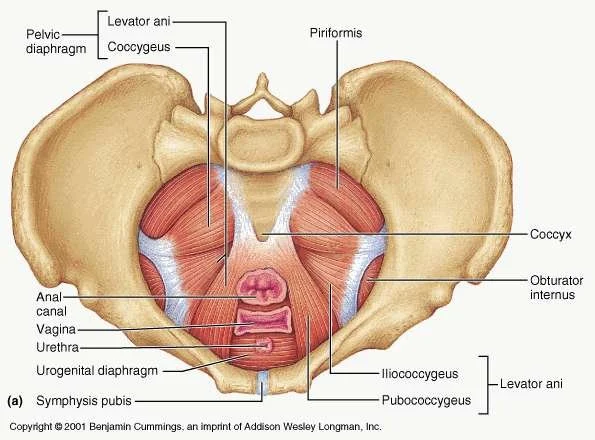Cystocele (SIS-toe-seel) is when the bladder drops from its usual position and presses on the vaginal wall. A type of pelvic organ prolapse, cystocele or anterior vaginal prolapse, can occur if the pelvic floor muscles are weak, the organ is not in the correct spot in the pelvis in general (especially post child birth) or if there is too much pressure put on the pelvic floor. Common causes of a prolapsed bladder include repetitive stress over time (e.g., coughing, improper lifting) or during vaginal childbirth.
3rd Trimester Fun!
The final trimester is all about growth and preparation – for you and baby! This can be another physically and emotionally challenging time as you prepare for birth; balance feelings like excitement, fatigue, and worry; and experience physical discomfort as the baby grows. This is also generally the time that you take lactation and birth prep classes.
Kegels
There is a reason that Kegels are considered the classic pelvic floor exercise. They are very effective for a lot of pelvic floor issues — when done correctly for the right type of dysfunction. So before you start doing them, make sure they are the right exercises for you by chatting with a pelvic floor PT first.
Obturator Internus Pelvic Floor Pain
The Obturator Internus (OI) is a muscle that sits deep in the hip girdle, running from the front of the pubic bones and inserting onto the greater trochanter (the top bony part of the thigh bone). The OI is a deep hip stabilizer, which means it helps stabilize the head of the femur (thigh bone) to keep it in socket. This muscle is also responsible for external rotation – or rolling out– of the hip and thigh. Additionally, the OI shares a fascial connection to most, if not all, of the deep pelvic floor muscles. People with dysfunction of the Obturator Internus often complete of a deep groin, hip or back pain that won’t go away with regular stretching.
Pelvic Health, Pelvic Floor Rehab, Pelvic Floor Exercises, Pelvic Pain, Pain with Intercourse, Melbourne, FL, Postpartum, Postpartum Rehab, Pee Leakage, Dr. Paige, Dr. Laura, Recharged Performance Therapy
Urge Incontinence
Urge incontinence occurs when you have a sudden desire to go to the bathroom due a very quick and powerful bladder contraction. This is sometimes followed by the involuntary loss of urine before you can make it to a toilet. Urge incontinence (UI) is characterized by the need to go often throughout the day – especially at night (nocturia) – with small amounts of urine actually released. “Frequent” means more than 8x during the day and >2 at night. Enuresis (bed wetting) may also occur.
Pelvic Health, Pelvic Floor Rehab, Pelvic Floor Exercises, Urge Incontinence, Melbourne, FL, Postpartum, Postpartum Rehab, Pee Leakage, Dr. Paige, Dr. Laura, Recharged Performance Therapy
Dribbling After You Pee
Overflow Incontinence occurs when your bladder doesn’t completely empty when you go to the bathroom. You may or may feel the urge *to go* with this type of incontinence. But it is very common for only small amounts of urine to be released throughout the day as your bladder refills- which means you go to the bathroom all the time because you aren’t really emptying.
Stress Urinary Incontinence - Pee Leakage
One important thing to *note* here is that a lot of “Dr. Google” resources on SUI is that Kegels (tightening your PF muscles) will help with leakage by making the muscles stronger. But this is usually not the case!! The vast majority of people with pelvic floor dysfunction (and SUI) have have PF muscles that are too tight – NOT too loose. Because muscles need to be a certain length to work optimally, a muscle that is too loose OR too tight can be weak.
Pain with Intercourse
Vestibulodynia- Pain at the Opening of the Vagina
Vestibulodynia is chronic pain or discomfort that occurs around the opening to the vagina: the vestibule is where the lips of the vulva meet your vagina. It is a very sensitive part of your body and contains multiple glands to help with lubrication/discharge as well as the urethra. Pain may occur when the area is touched, during sex, when using a tampon or other certain movements like prolonged sitting. The area may even be chronically red and inflamed.
Abdominal Organ Mobilization
4th Trimester Part 2!
The 4th trimester also includes your baby’s adjustment into this crazy, colorful world! Dr. Antony Karp is credited with creating the concept of the 4th trimester. He posts that full-term babies are born three months too early relative to other mammals. This is possibly so that the head can fit through the birth canal. But, the flip side is that your baby’s nervous system is not yet fully developed – and has a hard time handling life outside a quiet, safe womb.
Superfoods for Your Pelvic Floor
An important subset of the physical component is what we eat: the type of fuel we give our bodies directly affects how we move through the world. Both physically and mentally.
Pelvic Floor Physical Therapy, Pelvic Floor Rehab, Pelvic Floor Melbourne FL, Dr. Paige, Recharged Performance Therapy, Recharged Pelvic Floor
Doooowwwnn, Bessy!
Here are 3 AMAZING ways to help your pelvic floor stay relaxed and amazingly strong… and guess what! They have NOTHING to do with Kegels!!
We don’t have to live with a tight pelvic floor. There are some simple, practical habits you can incorporate into your daily routine to help loosen everything up. If these tips don’t feel like enough, going to a pelvic floor physical therapist to evaluate your specific needs might help!
Pelvic Floor Rehabilitation, Pelvic Floor PT, Pee Leakage, Urinary Frequency, Incontinence, Dr. Paige, Recharged Performance Therapy, Health, Hormones, women’s health
Stop Peeing Every 5 Minutes!
It is normal for most people to go to the bathroom six to eight times per day – maybe more if you drink a lot of water. IT IS NOT NORMAL for you to go to the bathroom more than every 2 hours UNLESS you have something that causes Bladder Irritation.
So what is Bladder irritation? This is where the inside lining of the bladder (this inside lining closely resembles the inside of your mouth) gets irritated and causes the bladder to contract.
Pelvic Floor rehabilitation, Pelvic Floor PT, Pee Leakage, Urinary Frequency, Incontinence, Dr. Paige, Recharged Performance Therapy
Mommy Tummy- Diastasis Recti
Diastasis Recti is a condition normally seen at the end of pregnancy and after birth. It is normal until about 12 weeks postpartum. If you are still experiencing a “gap” after 12 weeks, you need to see a Pelvic Floor Physical Therapist for Diastasis Recti!
Good News- There is a Pelvic Floor Physical Therapist for you here in Melbourne, FL!
Stress & Your Pelvic Floor
Stress can present itself in a lot of different ways. It may mean racing thoughts or never feeling quite settled -- like you just don’t have enough bandwidth for everything going on. Stress can also externalize itself in your body. This may mean having tight muscles that never relax no matter how much you stretch them or stress headaches or not sleeping well. This almost ALWAYS hits your pelvic floor!
September Update
COVID-19 and Pelvic Floor Problems
COVID-19 can highly effect things like pee leakage, pain during intercourse, lower back pain, pelvic organ prolapse and more.
This blog breaks down how COVID affects your pelvic floor in both its Mild version and the most severe versions of the virus.
Pelvic Floor Therapy, Pelvic Floor Physical Therapy, Pee Leakage, Incontinence, Diastasis Recti, Pain During Intercourse, COVID-19, Life After COVID
Pain in the Piriformis
The Piriformis comes in: a long, slender muscle about the size of a hotdog buried deep under our gluteus maximus muscle. It runs from the side of the sacrum (near the tailbone) to the femur (the top part of our thigh bone). It is considered part of the “deep six” hip rotators that are responsible for stability at the hip and pelvis, especially when we are moving.
There are two things we need to know about the piriformis: it is a workaholic and a drama queen. And schedule an appointment with pelvic floor physical therapy. You will thank us, we swear.
The #1 thing to do for your C-Birth Scar
Did you have a C-Birth (C-section)? If you did, or may have one in the future, then you NEED to read this latest installment to our Blog! We go over the easiest ways to help your scar heal and look better too! And schedule an appointment with pelvic floor physical therapy. You will thank us, we swear.
Cesarean Section




















